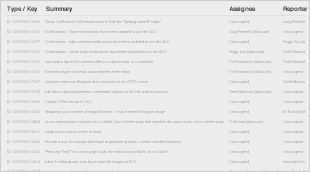Planned deadlines
| Milestone | Planned deadline | Actual deadline | Description of the Milestone | Comments |
|---|---|---|---|---|
| M0 |
| date as really committed |
|
|
| M1 |
|
| ||
| M2 |
|
| ||
| M3 |
|
| Critical - must be aligned with Juniper timeline | |
| M4 |
|
| ||
| RC0 |
|
|
The initial list of blueprints/features (from Juniper - as a reference)
| Feature name | Feature Lead | Modules (Components) | Approvers | BluePrint Specification links | |
|---|---|---|---|---|---|
| 1. | Provision for a knob (per service chain) to prevent reset of AS_PATH and maintain it through a service chain |
| |||
| 2. | Collapsed Spine L2/3 fabric A collapsed spine architecture has no leaf layer. Instead, the Layer 3 IP-based underlay and the EVPN-VXLAN overlay functionality that normally runs on leaf switches is collapsed onto the spine switches. | Vajrapu Venkata Rama Pradeep Kumar |
| ||
| 3. | Ubuntu 20.04 Support |
| |||
| 4. | Charmed OpenStack Ussuri Support | Anastasia Kravets |
| ||
| 5. | Data Plane Mac/IP Learning Mode for vRouter | Sivakumar Ganapathy |
| ||
| 6. | Combined FFU+ZIU upgrade from RHOSP13/CN19xx to RHOSP16.1/CN R2011 LTS |
| |||
| 7. | Optimize the workflow for LR in ERB Mode when creating IRB in the Fabric In ERB fabric, creating IRB unit for each VN on a device only if there is a local port (VPG) for the associated VN. This is done to reduce the device scale wrt. configuration and the traffic convergence time in some of the scenarios | Vajrapu Venkata Rama Pradeep Kumar |
| ||
| 8. | Contrail-2003/TCS P0: EVPN Type5 LR : Specific remote VN routes into added to the tenant VN and not the default route | Harsh Kumar |
| ||
| 9. | BFD/BGP sessions flapping on two computes | Narendranath Karjala |
| ||
| 10. | Qualify 5220 (EVO-based) as a lean spine in ERB fabric Supporting QFX-5220-132C and QFX-5220-32CD EVO based platforms. These platforms will be used as a lean spine/super-spine in ERB architecture. | Sahana Sekhar P C |
| ||
| 11. | DCI -EVPN using L2/3 DCI OTT - Phase 0 To stretch L2 virtual networks across fabrics in a multi-tenant environment by leaking the tenant virtual network route targets across the fabric | Parag Sanghvi |
| ||
| 12. | CaVA - Join to cluster | Tomasz Nowak |
| ||
| 13. | Fabric scale and performance as per PLM requests for R2011 Fabric scale with 256 physical devices along with overlay object scale
|
| |||
| 14. | 3-tier/5-stage fabric - support for single-plane superspine design (based on 'lean leaf' workaround today) Connecting multiple pods via super-spine layer which will behave either as lean device (IP transit) or Route-Reflector. | Abhinav Pandit |
| ||
| 15 | TF Operator Framework |
| |||
| 16 | RBAC support for fabric | Config , UI |
| ||
| 17 | New website for TF | UI |
| ||
| 18 | Support for Intel DDP | Contrail Dataplane (DPDK vRouter) | |||
